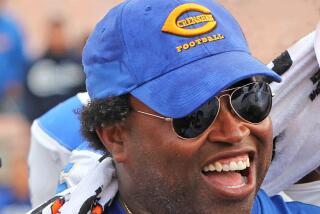Why We Live in the ‘Hood
- Share via
As more blacks leave the city for areas like Moreno Valley and Palmdale, and as neighborhoods like Watts and parts of South-Central become increasingly Latino, the Crenshaw area is arguably the city’s last remaining predominantly black neighborhood. Residents of the Crenshaw district and nearby areas tell MARY REESE BOYKIN why they have stayed in the neighborhood.
*
PAUL KNOX
Social studies teacher and head varsity football coach, Dorsey High School
Ihave been around the Crenshaw area all of my life. Two years ago, I purchased my current home in View Park. I always said that I wanted to live in the area because it is familiar to me.
I have access to everything a community needs: shopping centers and the amenities to take care of daily business. I enjoy the people. I live close to work at Dorsey. I was never one to ride the freeways.
I have a 17-year-old son, Brandon. Teenagers here face certain challenges, but not any more than the perils teens face in large cities across the nation. I taught my son to be cautious, to be smart and on the alert, but not to go around with the assumption that something bad will happen. I don’t want him to be afraid.
One main benefit of living in the Crenshaw area is that it gives me a chance to be a part of the African American community and to give back. Growing up, I was helped by people in this community, whether through organizations, team sports or in school. Living and working here are my chance to give back. When blacks who are successful remain in the community, our presence gives young people positive examples. It is more difficult to set an example if you don’t live in or frequent the community.
In my classes, I discuss the importance of patronizing community businesses instead of doing their shopping in Fox Hills or the Beverly Center. They have to understand that patronizing the businesses in their community helps build that community.
In my neighborhood, some parents choose public schools in the community; others bus their children to schools outside the nighborhood; some choose private schools. Brandon attended 54th Street Elementary School and Audubon Middle School. When it was time for him to enter high school, he went to Dorsey, where he is now a senior. Parents must ask themselves what are they saying about the community when children are bused out. What message is the child, who spends all of his nonschool hours in the community, given? So many of our kids who live in the area but attend school elsewhere have elitist attitudes. But our children must understand that the things we need to accomplish as a community can never be done when there is divisiveness.
*
CAROL GOODALL
Administrative assistant, UCLA
Igrew up on the Eastside (117th and Stanford), a place we considered a true neighborhood because whoever was at home watched and disciplined the kids who lived there. I have never found another neighborhood quite like that one.
In the early ‘60s, I moved to the West Adams area and lived there for eight years. I bought my first house near 10th Avenue and Crenshaw Boulevard. I raised my children there until their high school years, but my concern for their safety, frustration with the incorrigibility of some of the children in the neighborhood and their disrespect for adults caused me to move.
I rented a duplex in the Wilshire district, an area that I found quiet and peaceful. I came back to the Crenshaw district--not far from my first home here--in 1995 because the price was right. My neighbors are watchful and concerned. We look out for one another. If I see anyone who looks suspicious in the area, I call the police. I have had three home burglaries, so I put bars around my house and on the garage. I bolted the garage door.
I love living in the community. I like the places to eat, the places to shop. In December, various groups from throughout the city performed mini-concerts of Christmas carols. In February, in celebration of Black History Month, there are art displays. These activities provide more of a connection with others in the community.
*
RHONDA PAYNE
Real estate saleswoman
The Crenshaw district is among the areas where I sell homes. Prices range from $125,000 to four new homes in View Park that sold for more than $1 million. In the upper range, people are attracted to the larger homes, their character and style, and the accessibility to other areas.
Schools are a concern. There are a few good public schools in the area. However, upper-income buyers have allocated money for private schools. They know the tradeoff is a larger house at an affordable price, so they are willing to pay for private schools.
The Crenshaw district is improving. There are new business constructions in the area. There is the impending renovation of the Santa Barbara Plaza, which will bring in new retail outlets and eateries. As more businesses enter the Crenshaw district, then more money will be recycled back into the community. Eventually, more upscale stores, like the ones many Crenshaw residents frequent on the Westside or at the Beverly Center, will come into the area.
I think that regardless of where you live, safety is always a factor. I can’t think of anywhere that is crime-free.


